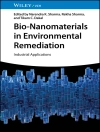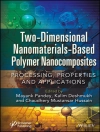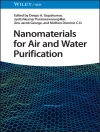This comprehensive three-volume handbook brings together a review of the current state together with the latest developments in sol-gel technology to put forward new ideas.
The first volume, dedicated to synthesis and shaping, gives an in-depth overview of the wet-chemical processes that constitute the core of the sol-gel method and presents the various pathways for the successful synthesis of inorganic and hybrid organic-inorganic materials, bio- and bio-inspired materials, powders, particles and fibers as well as sol-gel derived thin films, coatings and surfaces.
The second volume deals with the mechanical, optical, electrical and magnetic properties of sol-gel derived materials and the methods for their characterization such as diffraction methods and nuclear magnetic resonance, infrared and Raman spectroscopies.
The third volume concentrates on the various applications in the fields of membrane science, catalysis, energy research, biomaterials science, biomedicine, photonics and electronics.
Tabela de Conteúdo
Preface XXI
List of Contributors XXIII
Volume One: Synthesis and Processing
Part One Sol–Gel Chemistry and Methods 1
1 Chemistry and Fundamentals of the Sol–Gel Process 3
Ulrich Schubert
1.1 Introduction 3
1.2 Hydrolysis and Condensation Reactions 4
1.2.1 Silica-Based Materials 4
1.2.1.1 Precursor(s) 9
1.2.1.2 Catalyst (p H) 9
1.2.1.3 Alkoxo Group/H2O Ratio (Rw) 9
1.2.1.4 Solvent 10
1.2.1.5 Electrolytes 10
1.2.2 Metal Oxide-Based Materials 11
1.3 Sol–Gel Transition (Gelation) 17
1.3.1 Hydrolytic Sol–Gel Processes 17
1.3.2 Nonhydrolytic Sol–Gel Processes 22
1.3.3 Inorganic–Organic Hybrid Materials 22
1.4 Aging and Drying 24
1.5 Postsynthesis Processing 26
1.6 Concluding Remarks 26
References 27
2 Nonhydrolytic Sol–Gel Methods 29
Rupali Deshmukh and Markus Niederberger
2.1 Introduction 29
2.2 Nonaqueous Sol–Gel Routes to Metal Oxide Nanoparticles 31
2.2.1 Surfactant-Assisted Synthesis 31
2.2.2 Solvent-Controlled Synthesis 33
2.2.2.1 Benzyl Alcohol Route 33
2.2.2.2 tert-Butyl Alcohol Route 37
2.2.2.3 Ether Route 37
2.2.2.4 Acetophenone Route 38
2.2.2.5 Carboxylic Acid Route 39
2.2.2.6 Benzylamine Route 39
2.2.3 Microwave-Assisted Synthesis 40
2.3 Nonaqueous Sol–Gel Synthesis beyond Metal Oxides 43
2.3.1 Composites 43
2.3.2 Organic–Inorganic Hybrid Materials 44
2.3.3 Metal Sulfides 46
2.3.4 Metals 47
2.4 Chemical Reaction and Crystallization Mechanisms 48
2.4.1 Introduction 48
2.4.2 Overview of the Main Chemical Reactions 49
2.4.3 Classical and Nonclassical Crystallization Mechanisms 51
2.4.4 Selected Examples 51
2.5 Assembly and Processing 56
2.5.1 Introduction 56
2.5.2 Nanoparticle Arrays and Superlattices 57
2.5.3 Oriented Attachment and Mesocrystals 59
2.5.4 Films 60
2.6 Summary and Outlook 63
References 63
3 Integrative Sol–Gel Chemistry 71
M. Depardieu, N. Kinadjian, D. Portehault, R. Backov, and Clément Sanchez
3.1 Introduction 71
3.2 Design of 0D Structures 72
3.2.1 Aerosol Processing 72
3.2.2 Capsules 75
3.2.2.1 Simple Emulsions Preparation 76
3.2.2.2 Mineralization of the Wax Dispersion 76
3.2.2.3 Temperature-Triggered Release 77
3.2.2.4 Introducing a Hydrophilic Compartment 79
3.2.2.5 Water@Wax@Water Emulsion Formulation 80
3.2.2.6 Water@Wax@Water Emulsion Mineralization 80
3.2.2.7 Temperature-Triggered Release 81
3.2.2.8 Wax@Water@Oil Emulsion Formulation 83
3.2.2.9 Wax@Water@Oil Emulsion Mineralization 84
3.2.2.10 Temperature-Triggered Release 85
3.3 Design of 1D Macroscopic Structures 88
3.3.1 Electrospinning 89
3.3.1.1 A First Case: Ti O2 Fibers for Dye-Sensitized Solar Cells 89
3.3.1.2 Coupling Sol–Gel Reactions and Electrospinning 90
3.3.2 Extrusion 93
3.3.2.1 V2O5 Fibers as Alcohol Sensor 94
3.3.2.2 Composite Fibers Prepared with the Help of Polymer Dehydration/Reticulation 96
3.4 Design of Extended 2D Structures 99
3.5 Design of Extended 3D Structures 99
3.5.1 Foams 99
3.5.1.1 Silica Foams: Si-(HIPE) 101
3.5.1.2 Eu3+@Organo-Si-(HIPE): Photonic Properties 101
3.5.1.3 Pd@Organo-Si-(HIPE): Cycling Heck Catalysis Reactions 103
3.5.1.4 Enzyme@Organo-Si-(HIPE): High Efficiency Biocatalysts 104
3.5.1.5 Si-(HIPE) as Hard Template to Carbonaceous Foams and Applications 106
3.5.1.6 Carbon-(HIPE) as Li Ion Negative Electrodes 107
3.5.1.7 Li BH4@Carbon-(HIPE) for Hydrogen Storage and Release 107
3.5.2 Aerogels 112
3.5.3 Dense Nanostructured Monoliths 112
3.6 Conclusions 113
References 115
4 Synthetic Self-Assembly Strategies and Methods 121
Alexandra Zamboulis, Olivier Dautel, and Joël J.E. Moreau
4.1 Introduction 121
4.2 Templated Synthesis of Inorganic Materials 122
4.2.1 Self-Assembly of Mesoporous Silicas 123
4.2.2 Hydrothermal Rearrangement and Postsynthesis Treatment 125
4.2.3 Self-Assembly of Thin Films 126
4.2.4 Self-Assembly of Functionalized Mesoporous Silicas 127
4.3 Self-Assembled Organosilicas 128
4.3.1 Control of the Pore Structure: Templated Synthesis of Mesoporous Bridged Silsesquioxanes 129
4.3.2 Self-Organized Organosilicas 132
4.3.3 Self-Assembly Synthetic Strategies for Organosilicas with Optical Properties 139
4.3.3.1 Toward an H-Aggregation/Card Pack Stacking 141
4.3.3.2 From a J- to an H-Aggregation 149
4.3.3.3 Transcription of the J-Aggregation from the Precursor to the Material 153
4.4 Conclusions 154
References 154
5 Processing of Sol–Gel Films from a Top-Down Route 165
Plinio Innocenzi and Luca Malfatti
5.1 Introduction 165
5.2 Top-Down Processing by UV Photoirradiation 167
5.2.1 UV Curing of Oxides 167
5.2.2 UV Curing of Hybrid Sol–Gel Films 169
5.2.3 UV Photoirradiation of Mesoporous Films 170
5.2.4 Nanocomposite So–Gel Films by UV Photoirradiation 173
5.3 Laser Irradiation and Writing 174
5.3.1 Thermal-Induced Effects 174
5.3.2 Laser-Induced Microfabrication 175
5.3.3 Nanofabrication by Two- or Multiphoton Absorption 177
5.4 Electron Beam Lithography 178
5.5 Top-Down Processing by Hard X-Rays 181
5.6 Soft X-Ray Lithography 184
References 186
6 Sol–Gel Precursors 195
Vadim G. Kessler
6.1 Introduction 195
6.2 Simple Silicon Alkoxides 196
6.3 Functional and Mixed Ligand Silicon Alkoxides for More Facile Hydrolysis 197
6.4 Functional Silicon Alkoxides: Precursors of Hybrid Materials 198
6.5 Simple Metal Alkoxides 200
6.5.1 Commercially Available Simple Metal Alkoxide 202
6.5.2 Customary Synthesis of Metal Alkoxide Precursors 209
6.5.2.1 Interaction of Metals with Alcohols 209
6.5.2.2 Alcoholysis of Complexes Derived from Volatile Acids Weaker Than Alcohols 209
6.5.2.3 Basic Alcoholysis of Metal Halides: Metathesis Reaction 210
6.5.2.4 Alcoholysis of Metal Oxides 210
6.5.2.5 Electrochemical Oxidation of Metals in Alcohols 211
6.5.2.6 Alcohol Interchange Reaction 211
6.6 Functional and Mixed Ligand Metal Alkoxides for More Facile Hydrolysis and Stabilization of Resulting Colloids 212
6.7 Precursor and Solvent Choice for Nonhydrolytic Sol–Gel Processes 213
6.8 Synthesis of Complex Materials: Single-Source Precursor Approach 214
6.9 Sol–Gel Precursors for Special Applications: Biomedical and Luminescent 215
Abbreviations 216
References 216
Part Two Sol–Gel Materials 225
7 Nanoparticles and Composites 227
Guido Kickelbick
7.1 Introduction 227
7.2 Aqueous Sol–Gel Process 228
7.2.1 Silica Nanoparticles 228
7.2.1.1 Properties of Silica Nanoparticles 230
7.2.2 Metal Oxides 231
7.3 Nonaqueous Sol–Gel Process 232
7.3.1 Metal Oxides 232
7.4 Surface Functionalization of Nanoparticles 234
7.5 Nanocomposites 236
7.5.1 Dispersion of Silica Nanoparticles in Polymer Matrices 237
7.5.2 In Situ Production of Silica Particles in a Polymer Matrix 237
7.5.3 Melt Production of Silica Particles in a Polymer Matrix 238
7.5.4 Properties of Nanoparticle Polymer Nanocomposites 238
7.6 Conclusions 239
References 239
8 Oxide Powders and Ceramics 245
Maria Zaharescu and Luminita Predoana
8.1 Oxide Powders Obtained by Sol–Gel Methods 245
8.2 Ceramics from Sol–Gel Oxide Powders 248
8.3 Pure and Doped Single Oxide Ceramics 249
8.3.1 Nanocrystalline Yttria 249
8.3.2 Gd-Doped Ceria 249
8.4 Multicomponent Ceramics 250
8.4.1 Zirconium Titanate 250
8.4.2 Lead Titanate 251
8.4.3 Zr-Doped Pb Ti O3 251
8.4.4 Nb-Doped PZT 252
8.4.5 W-Doped PZT 252
8.4.6 Ca-Doped Pb Ti O3 253
8.4.7 Barium Titanate 255
8.4.8 (Er, Yb)-Doped Ba Ti O3 256
8.4.9 Barium Strontium Titanate 256
8.4.10 Co-Doped Barium Strontium Titanate 257
8.4.11 Mg-Doped Barium Strontium Titanate 257
8.4.12 Magnesium Titanate 257
8.4.13 B-Doped Mg Ti O3 258
8.4.14 Calcium Titanate 258
8.4.15 Ca Ti O3–(Sm, Nd)Al O3 Solid Solution 259
8.4.16 (Co, Cu)-Doped Calcium Titanate 259
8.4.17 (Na, K)-Doped Bismuth Titanate 260
8.4.18 Mg-Doped Barium Tantalate 261
8.4.19 Lead-Free Ba(Fe0.5Nb0.5)O3 261
8.4.20 B-Doped Mg4Nb2O9 261
8.4.21 Ce-Doped Lutetium Aluminum Garnet 262
8.4.22 Ce-Doped Barium Yttrium Garnet 263
8.4.23 Aluminum Titanate 263
8.4.24 Magnesium Aluminum Titanate 264
8.4.25 Lanthanum Cobaltite 265
8.5 Composite Ceramics 266
8.5.1 Al2O3–Zr O2 Nanocomposite 266
8.5.2 Alumina–Yttrium Aluminum Garnet 269
8.6 Conclusions 269
References 270
9 Thin Film Deposition Techniques 277
David Grosso, Cédric Boissière, and Marco Faustini
9.1 Introduction 277
9.2 General Aspects of Liquid Deposition Techniques 280
9.2.1 A Multistep Process between Chemistry and Engineering 280
9.2.2 Initial Solution (Sol–Gel Chemistry) 280
9.2.3 Deposition Step (Solution Spreading) 283
9.2.4 Evaporation Step (Progressive Concentration) 284
9.2.5 Optional Patterning Processes 288
9.2.6 Postdeposition Treatments (Stabilization, Consolidation, and Modification) 288
9.3 Spin Coating 289
9.3.1 Generalities on Spin Coating 289
9.3.2 Fundamentals of Spin Coating 290
9.3.3 Advantages and Drawbacks of Spin Coating 294
9.3.4 Some Critical Examples of Films Prepared by Spin Coating 295
9.4 Dip Coating 296
9.4.1 Generalities on Dip Coating 296
9.4.2 Fundamentals of Dip Coating 297
9.4.2.1 Model for the Capillarity Regime 299
9.4.2.2 Model for the Draining Regime 300
9.4.2.3 Combining Models to Describe Simultaneously Both Regimes 301
9.4.3 Advantages and Drawbacks of Dip Coating 302
9.4.4 Some Critical Examples of Films Prepared by Dip Coating 302
9.5 Alternative and Emerging Techniques 304
9.5.1 Roll-to-Roll Coating Techniques 304
9.5.2 Droplet-Assisted Deposition (Aerosol and Inkjet) 304
9.5.3 Electro-assisted Deposition 308
9.6 General Perspectives 310
References 310
10 Monolithic Sol–Gel Materials 317
Raz Gvishi
10.1 Introduction 317
10.2 Principles of Sol–Gel Monolith Fabrication 319
10.2.1 Hydrolysis and Condensation 319
10.2.2 Role of Drying in Monolith Fabrication 320
10.2.3 Chemical Composition Effects 321
10.2.3.1 Metal Alkoxide Precursor Types 321
10.2.3.2 p H Effect: Type of Catalyst Used 321
10.2.3.3 H2O: Si Molar Ratio (R) 322
10.2.3.4 Steric Effect of Precursor Ligand Groups 323
10.2.3.5 Functionality of Organically Modified Silanes 323
10.3 Routes for Fabrication of Monoliths 324
10.3.1 Xerogel Monoliths 325
10.3.1.1 Methods for Preparing Nonsilica Xerogel Monoliths 325
10.3.1.2 Methods for Preparing Silica Xerogel Monoliths 327
10.3.2 Organically Modified Silane Monoliths 329
10.3.2.1 ORMOSIL Inorganic–Organic Hybrid Monoliths in One Phase 330
10.3.2.2 Hybrid Monoliths by Fast Sol–Gel (FSG) Process 331
10.3.3 Multiphasic Composite Hybrid Monoliths 333
10.3.4 Aerogel Monoliths 338
10.4 Summary 339
References 340
11 Hollow Inorganic Spheres 345
Atsushi Shimojima
11.1 Introduction 345
11.2 General Strategies 345
11.2.1 Templating Methods 345
11.2.2 Template-Free Methods 347
11.3 Typical Synthesis Procedures 347
11.3.1 Hollow Silica Particles 347
11.3.2 Hollow Mesoporous Silica Particles 350
11.3.3 Hollow Organosilica Nanoparticles 354
11.3.4 Hollow Crystalline Silicate Particles 355
11.3.5 Hollow Titania (Ti O2) Particles 357
11.3.6 Hollow Particles of Other Metal Oxides 359
11.4 Applications 360
11.4.1 Antireflective Coatings 360
11.4.2 Catalysis 361
11.4.3 Lithium Ion Battery 362
11.4.4 Biomedical Applications 363
11.5 Summary 365
References 365
12 Sol–Gel Coatings by Electrochemical Deposition 373
Liang Liu and Daniel Mandler
12.1 Introduction 373
12.2 Mechanism of the Sol–Gel Electrochemical Deposition 374
12.3 Manipulation of the Sol–Gel Electrochemical Deposition 379
12.3.1 Effect of Deposition Parameters 379
12.3.2 Electrochemical Deposition of Nanostructured Silica Thin Films 383
12.3.3 Selective Electrochemical Deposition on Patterns 385
12.3.4 Local Electrochemical Deposition of Sol–Gel Films by Scanning Electrochemical Microscopy 386
12.4 Electrochemical Codeposition of Sol–Gel-Based Hybrid and Composite Films 388
12.4.1 Electrodeposition of Sol–Gel-Based Hybrid Films 389
12.4.2 Electrodeposition of Sol–Gel-Based Composite Films 390
12.5 Applications of Electrochemically Deposited Sol–Gel Films 394
12.5.1 Corrosion Protection and Adhesion Promotion 394
12.5.2 Electrochemical Sensors 397
12.5.3 Biocomposite Films 400
12.5.4 Other Applications 405
12.6 Summary 408
Abbreviations for Silanes 409
Acknowledgments 410
References 410
13 Nanofibers and Nanotubes 415
Il-Doo Kim and Seon-Jin Choi
13.1 Introduction 415
13.2 Nanofibers 415
13.2.1 Electrospinning Process 416
13.2.2 Polymer Nanofibers 417
13.2.3 Metal Nanofibers 419
13.2.4 Metal Oxide Nanofibers 421
13.2.5 Multicomposite Nanofibers 424
13.2.6 Graphene-Functionalized Nanofibers 426
13.3 Nanotubes 427
13.3.1 Direct Synthetic Methods of Nanotubes 427
13.3.1.1 Hydrothermal Synthetic Routes 427
13.3.1.2 Electrochemical Synthetic Routes 428
13.3.1.3 Electrospinning Routes 428
13.3.2 Indirect Synthetic Methods of Nanotubes 431
13.3.2.1 AAO Templating Routes 431
13.3.2.2 Inorganic Layer Templating Routes 432
13.3.2.3 Polymer Templating Routes 434
13.3.2.4 Electrospun Nanofiber Templating Route 436
13.4 Summary and Future Perspectives 439
References 439
14 Nanoarchitectures by Sol–Gel from Silica and Silicate Building Blocks 443
Pîlar Aranda, Carolina Belver, and Eduardo Ruiz-Hitzky
14.1 Introduction 443
14.2 Porous Clay Nanoarchitectures Using Sol–Gel Approaches 444
14.3 Porous Nanoarchitectures from Delaminated Clays 450
14.4 Fibrous Silicates as Building Blocks in Sol–Gel Nanoarchitectures Derived from Clays 457
14.5 Conclusion 464
Acknowledgments 465
References 465
15 Sol–Gel for Metal Organic Frameworks (MOFs) 471
Kang Liang, Raffaele Ricco, Julien Reboul, Shuhei Furukawa, and Paolo Falcaro
15.1 Introduction 471
15.2 Design and Synthetic Strategies of MOF–Sol–Gel-Based Structures 472
15.2.1 MOFs Hosting Sol–Gel-Based Structures 472
15.2.2 Surface Chemical Functionalization of Sol–Gel Materials and Ceramics for MOF Technology 475
15.2.2.1 Nano/Microparticles 475
15.2.2.2 Thin Films 476
15.2.2.3 Membranes and Monoliths 477
15.2.3 Engineered Ceramics and Hybrid Materials for Controlled MOF Nucleation and Growth 478
15.2.3.1 Nano/Microparticles 478
15.2.3.2 Thin Films and Membranes 479
15.2.4 Conversion from Ceramics for the Fabrication of MOFs 480
15.3 Conclusion and Remarks 482
Acknowledgments 483
References 483
16 Silica Ionogels and Ionosilicas 487
Peter Hesemann, Lydie Viau, and André Vioux
16.1 Introduction 487
16.2 Ionogels 488
16.2.1 Brief Presentation of ILs 488
16.2.2 Sol–Gel in Ionic Liquids 489
16.2.2.1 Formic Acid Solvolysis Sol–Gel Way 490
16.2.2.2 Hydrolysis Sol–Gel Way 491
16.2.2.3 Mesoporous Silicas from Ionogels 492
16.2.2.4 Particulate Ionogels 492
16.2.3 Applications of Ionogels 493
16.2.3.1 Conducting Properties of Confined ILs 493
16.2.3.2 Hybrid Host Matrices for Ionogel Electrolytes 494
16.2.3.3 Ionogel Electrolytes for Lithium Batteries 495
16.2.3.4 Proton-Conducting Ionogel Membranes 495
16.2.3.5 Ionogel Electrolytes for Solar Cells 495
16.2.3.6 Ionogels Incorporating Task-Specific Solutes 495
16.2.3.7 Ionogels for Drug Release Systems 497
16.3 Ionosilicas 497
16.3.1 Definitions 497
16.3.1.1 Synthesis of Ionosilicas 498
16.3.2 Synthesis of Surface-Functionalized Ionosilicas 498
16.3.2.1 Postsynthesis Grafting Reactions 500
16.3.2.2 Cocondensation Reactions 500
16.3.3 Hybrid Ionosilicas 504
16.3.4 Ionic Nanoparticles and Ionic Nanoparticle Networks 505
16.3.5 Applications of Ionosilicas 506
16.3.5.1 Catalysis 506
16.3.5.2 Anion Exchange Reactions 507
16.3.5.3 Molecular Recognition 507
16.4 Conclusion 508
References 508
17 Aerogels 519
Shanyu Zhao, Marina S. Manic, Francisco Ruiz-Gonzalez, and Matthias M. Koebel
17.1 Introduction and Brief History 519
17.2 Synthesis and Processing 521
17.2.1 Gel Preparation 521
17.2.1.1 Silica Gels 521
17.2.1.2 Nonsilica Inorganic Oxide Gels 527
17.2.1.3 Organic and Biopolymer Gels 529
17.2.1.4 Exotic Gels 534
17.2.2 Gel Aging and Solvent Exchange 535
17.2.2.1 Aging Process 535
17.2.2.2 Effect of Solvent Exchange 536
17.2.3 Gel Modification and Chemical Functionalization 537
17.2.4 Gel Drying 538
17.2.4.1 Freeze-Drying 539
17.2.4.2 Ambient Pressure Drying 540
17.2.4.3 Supercritical Drying 543
17.2.4.4 High-Temperature Supercritical Drying 544
17.2.4.5 Low-Temperature Supercritical Drying 545
17.3 Characterization Methods 546
17.3.1 Structural Characterization 547
17.3.2 Chemical Characterization 548
17.3.3 Thermal Characterization 549
17.3.4 Mechanical Characterization 550
17.3.5 Optical Characterization 552
17.4 Selected Examples and Applications 553
17.4.1 Aerogels for Superinsulation 554
17.4.1.1 Silica Aerogels 555
17.4.1.2 Organic Aerogels 555
17.4.2 Aerogels for Catalysis: Chemistry Applications 556
17.4.2.1 Silica-Based Aerogel 556
17.4.2.2 Alumina-Based Aerogel 556
17.4.2.3 Titania-Based Aerogel 557
17.4.2.4 Zirconia-Based Aerogel 557
17.4.2.5 Carbon Aerogels 557
17.4.2.6 Other Mixed Oxides Composite Aerogels 558
17.4.3 Aerogels for Supercapacitor and Battery Research 558
17.4.4 Aerogels in Space Exploration 558
17.4.5 Aerogels for Biomedical Applications 559
17.5 Trends, Conclusion, and Outlook 559
17.5.1 Small Volume–High Specialization 559
17.5.2 Large Volume–High Performance 560
17.5.3 Outlook 561
References 562
18 Ordered Mesoporous Sol–Gel Materials: From Molecular Sieves to Crystal-Like Periodic Mesoporous Organosilicas 575
Sílvia C. Nunes, Paulo Almeida, and Verónica de Zea Bermudez
18.1 Introduction 575
18.2 Synthesis Mechanisms of Periodic Mesoporous Silica Materials 577
18.2.1 Liquid Crystal Templating 578
18.2.2 Cooperative Self-Assembly 578
18.2.3 Evaporation-Induced Self-Assembly Mechanism 579
18.2.4 Soft Templating 580
18.3 Functionalization of Periodic Mesoporous Silica Materials 582
18.3.1 Postsynthetic Grafting 583
18.3.2 Direct Synthesis 583
18.4 Periodic Mesoporous Organosilicas 584
18.4.1 Synthesis Mechanisms 584
18.4.2 Multifunctionalization 586
18.4.3 Periodic Mesoporous Organosilicas with Amorphous Wall Structure 587
18.4.4 Periodic Mesoporous Organosilicas with Crystal-Like Wall Structure 587
18.4.5 Functionalization of Crystal-Like Periodic Mesoporous Organosilicas and Figures of Merit 591
18.5 Future Trends 595
Acknowledgments 596
References 596
19 Biomimetic Sol–Gel Materials 605
Carole Aimé, Thibaud Coradin, and Francisco M. Fernandes
19.1 Introduction 605
19.2 Natural Sol–Gel Materials 606
19.2.1 Biogenic Oxides 606
19.2.2 Biochemical Conditions of Silica Formation 609
19.2.3 Chemical Features of Biogenic Silica 610
19.2.3.1 Silica Deposit in Higher Plants 610
19.2.3.2 Diatoms Frustule 611
19.2.3.3 Sponges Spicule 612
19.2.4 Properties and Applications 614
19.2.5 Overview 617
19.3 Biomimetic Sol–Gel Chemistry 618
19.3.1 Chemical Background from Biosilicification Processes 618
19.3.1.1 Silaffins 618
19.3.1.2 Silicateins 620
19.3.2 Silicatein-Derived Biomimetic Sequences: From Proteins to Amino Acids 624
19.3.2.1 Enzymes and Peptides 624
19.3.2.2 Rational Design 625
19.3.3 Silaffins-Derived Biomimetic Sequences Based on Polyamines 628
19.3.3.1 Long-Chain Polyamines: Silica Formation and Morphogenesis Control 628
19.3.3.2 Short-Chain Amines 629
19.3.3.3 R5 Peptide 630
19.3.4 Overview 630
19.4 Biohybrid Materials from Bioinspired Mineralization Strategies 631
19.4.1 Mineralization of Biomacromolecules 632
19.4.1.1 Proteins 632
19.4.1.2 Polysaccharides 635
19.4.1.3 Complex Coacervates 636
19.4.2 Mineralization of Microorganisms 637
19.4.3 Materials and Devices Based on Biomimetic and Bioinspired Mineralization 638
19.4.4 Overview 641
19.5 Conclusions 641
References 642
Volume Two: Characterization and Properties of Sol-Gel Materials
Part Three Characterization Techniques for Sol–Gel Materials 651
20 Solid-State NMR Characterization of Sol–Gel Materials: Recent Advances 653
Florence Babonneau, Christian Bonhomme
21 Time-Resolved Small-Angle X-Ray Scattering 673
Johan E. ten Elshof, Rogier Besselink, Tomasz M. Stawski, Hessel L. Castricum
22 Characterization of Sol–Gel Materials by Optical Spectroscopy Methods 713
Rui M. Almeida, Jian Xu
23 Properties and Applications of Sol–Gel Materials: Functionalized Porous Amorphous Solids (Monoliths) 745
Kazuki Nakanishi
24 Sol–Gel Deposition of Ultrathin High-κ Dielectric Films 767
An Hardy, Marlies K. Van Bael
Part Four Properties 787
25 Functional (Meso)Porous Nanostructures 789
Andrea Feinle, Nicola Hüsing
26 Sol–Gel Magnetic Materials 813
Lucía Gutiérrez, Sabino Veintemillas-Verdaguer, Carlos J. Serna, María del Puerto Morales
27 Sol–Gel Electroceramic Thin Films 841
María Lourdes Calzada
28 Organic–Inorganic Hybrids for Lighting 883
Vânia Teixeira Freitas, Rute Amorim S. Ferreira, Luis D. Carlos
29 Sol–Gel Ti O2 Materials and Coatings for Photocatalytic and Multifunctional Applications 911
Yolanda Castro, Alicia Durán
30 Optical Properties of Luminescent Materials 929
Sidney J.L. Ribeiro, Molíria V. dos Santos, Robson R. Silva, Édison Pecoraro, Rogéria R. Gonçalves, José Maurício A. Caiut
31 Better Catalysis with Organically Modified Sol–Gel Materials 963
David Avnir, Jochanan Blum, Zackaria Nairoukh
32 Hierarchically Structured Porous Materials 987
Ming-Hui Sun, Li-Hua Chen, Bao-Lian Su
33 Structures and Properties of Ordered Nanostructured Oxides and Composite Materials 1031
María Luz Martínez Ricci, Sara A. Bilmes
Volume Three: Application of Sol-Gel Materials
Part Five Applications 1055
34 Sol–Gel for Environmentally Green Products 1057
Rosaria Ciriminna, Mario Pagliaro, Giovanni Palmisano
35 Sol–Gel Materials for Batteries and Fuel Cells 1071
Jadra Mosa, Mario Aparicio
36 Sol–Gel Materials for Energy Storage 1119
Leland Smith, Ryan Maloney, Bruce Dunn
37 Sol–Gel Materials for Pigments and Ceramics 1145
Guillermo Monrós
38 Sol–Gel for Gas Sensing Applications 1173
Enrico Della Gaspera, Massimo Guglielmi, Alessandro Martucci
39 Reinforced Sol–Gel Silica Coatings 1207
Antonio Julio López, Joaquín Rams
40 Sol–Gel Optical and Electro-Optical Materials 1239
Marcos Zayat, David Almendro, Virginia Vadillo, David Levy
41 Luminescent Solar Concentrators and the Ways to Increase Their Efficiencies 1281
Renata Reisfeld
42 Mesoporous Silica Nanoparticles for Drug Delivery and Controlled Release Applications 1309
Montserrat Colilla, Alejandro Baeza, María Vallet-Regí
43 Sol–Gel Materials for Biomedical Applications 1345
Julian R. Jones
44 Self-Healing Coatings for Corrosion Protection of Metals 1371
George Kordas, Eleni K. Efthimiadou
45 Aerogel Insulation for Building Applications 1385
Bjørn Petter Jelle, Ruben Baetens, Arild Gustavsen
46 Sol–Gel Nanocomposites for Electrochemical Sensor Applications 1413
Pengfei Niu, Martí Gich, César Fernández-Sánchez, Anna Roig
Index 1435
Sobre o autor
David Levy is a Research Professor and head of the Sol-Gel Group at the Materials Science Institute of Madrid (ICMM) of the Consejo Superior de Investigaciones Cienti cas. His research interests are optical materials (bulk materials; thin- lm coatings as AR optical coatings, protection transparent coatings and functional coatings; oxide nanoparticles) and liquid crystal materials, by Sol-Gel processing and their applications. During his time at The Hebrew University of Jerusalem David Levy pioneered the sol-gel process for the preparation of organically doped silica-gel glasses. He has more than 130 publications and a number of patents to his name, and has received numerous prizes in recognition of his groundbreaking work on sol-gel materials, including the ?First Ulrich Prize? and the nomination to King Juan Carlos-I research award.
Marcos Zayat is currently vice-director of the Materials Science Institute of Madrid (ICMM). His scienti c interests are centered on the design of new optical coatings and the characterization of their physicochemical properties. After having obtained his Ph D in Materials Science from The Hebrew University of Jerusalem in 1997, Marcos Zayat joined the ICMM where he continues developing sol-gel materials for optical and electrooptical applications. He has published more than fty original articles in prestigious scienti c journals.












